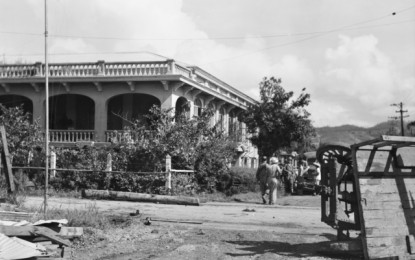
MACARTHUR RESIDENCE. The Price Mansion built in 1910 as seen in this photograph taken in October 1944 in Tacloban. The building became the residence and headquarters of Gen. Douglas MacArthur after they landed in Leyte. (Photo from Australian War Memorial website)
TACLOBAN CITY -- The Japanese occupation in the Philippines between 1942 and 1945 is one of the most painful parts of Philippine history and its memory should always be remembered and never be forgotten by the young generation, said an old lady who survived World War II.
Although the Japanese occupation left a painful mark in the lives of Filipinos, the arrival of Allied forces set a different tone, said Bernardita Valenzuela, 90, a member of the board of the Leyte Metropolitan Water District.
“You should never ever forget it. That is a major event in the history of our country. We suffered during the Japanese occupation. We always love democracy and all of a sudden, there was no democratic process during that time,” Valenzuela told reporters on Thursday.
“They would pick you up anytime without observance of any law. Naturally, we love democracy and when the Americans came, it was heaven-sent,” she added.
Her family was in Tacloban when members of the Japanese Imperial Army came. Her father was the only professional dentist in Leyte and Samar provinces during World War II, allowing him to practice his job even during the critical period.
Valenzuela was just 15 when American Gen. Douglas MacArthur fulfilled his promise of returning to liberate the country from the hands of Japanese soldiers.
“I was attending Nippongo class at Leyte High School when I heard the sound of planes. I looked up in the sky and when I saw the red, white and blue stripes, I shouted ‘the Americans are here!’” Valenzuela recalled.
At her young age, she was fully aware of the importance of the liberation forces’ arrival, especially after his brother’s ordeal in the hands of the Japanese invaders.
The Japanese army captured her brother, Felisimo Benedicto, for listening to “Voice of America”, a radio program that provided people with information on the US’ efforts during World War II. It was also used to provide hope and to counteract the propaganda espoused by America's enemies in the conflict.
“He was put inside a structure that is too narrow that you couldn’t even move. He was treated like an animal for one month without food ration. For a month, my family brought food to him, but we have to throw it inside because we could not enter the structure,” she added.
“I hated all the Japanese. My mother never allowed a Japanese to enter our house even years after the war,” she said. “At that stage of my life, I prayed that the Americans would come. When Gen. McArthur walked on the streets of Tacloban around 2 p.m., we were all shouting and rejoicing.”
Although she could not forget the experience of her family in the hands of Japanese soldiers, Valenzuela said she had already forgiven them.
Today, there are still structure in the city that reminds people about the Liberation such as the Price Mansion, the residence and headquarters of MacArthur and the Leyte Provincial Capitol, the seat of the Philippine government shortly after the end of the Japanese invasion.
The capitol building became the seat of the Philippine Commonwealth from 1944 to 1945 as the Allied forces liberated the Philippine islands from Japanese control. Osmeña was sworn in as President by MacArthur inside the building, now being used as office space by the Leyte provincial government.
The Redoña Residence, the wooden house where Osmeña and other key government officials stayed, was demolished last year due to the absence of maintenance funds.
Osmeña resided in Tacloban until Manila was liberated by the Allied forces in February 1945.
Cristina Redoña-Pablo, was just 15 when Osmeña stayed in Tacloban, recalled that her family has to stay in a stock room since their house is fully-occupied by the President’s staff.
“One of the reasons why my father offered our house as the President’s residence because it is near the capitol. In fact, the President just walked from our house to the capitol,” Pablo said. “There are times during the stay of President Osmeña in our house where he would call all children to gather and watch a movie with him.”
On Oct. 20, the province will commemorate the 75th Leyte Gulf Landings, the largest naval battle ever fought in modern history. It was fought in four separate engagements near the islands of Leyte, Samar, and Luzon from Oct. 23 to 26 in 1944.
MacArthur, at the head of the largest US fleet of transport and warships, and accompanied by Osmeña and Gen. Carlos P. Romulo, landed at the Red Beach of nearby Palo town on Oct. 20, 1944 to reclaim the Philippines from the Japanese. (PNA)
